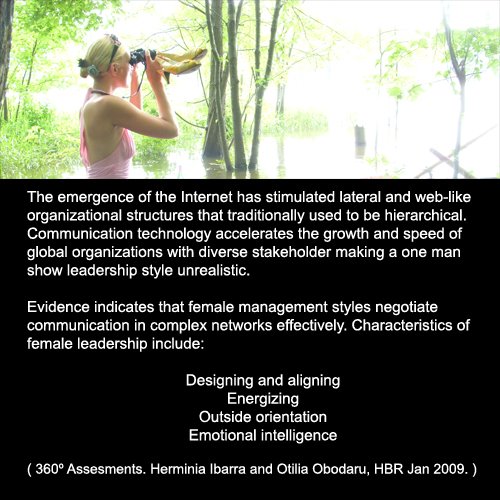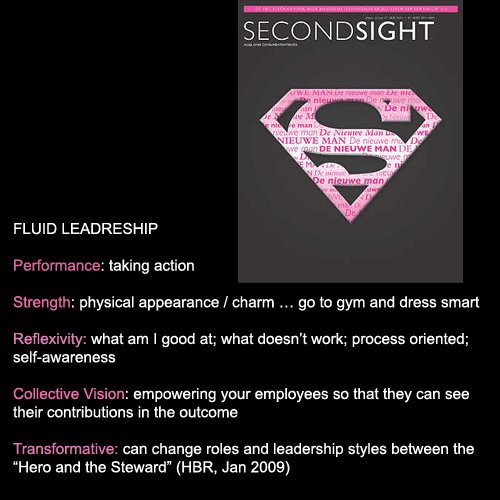|
Personae
Fluid Leadership: Style Traits for Today's Empowering Leaders
Crisis is all over the media. Losing jobs, deficits and bankruptcy cast an ominous shadow on our economic future. We will need leaders to help us move back into prosperity, but has leadership changed?
WHO'S THE MAN?
Crisis is all over the media. Losing jobs, deficits and bankruptcy cast an ominous shadow on our economic future. We will need leaders to help us move back into prosperity, but has leadership changed? And are there differences between so-called male / female leadership traits - as opposed to masculine leadership styles that might be displayed by women and men alike? This article explores the changing role of men's leadership and asks "Who's the man?"
Bron: http://portaltoyourdreamsblog.blogspot.com/ 4 mei 2009
The man and leadership is not about one person but what it means to be a 'manly' or 'masculine' leader. Traditionally, the man has taken on the role as hunter and defender of the home. It's in our DNA to take risks and fight for our own. Then why did the "Metro Man" emerge? Are skin creams and sharing emotions the new sword and shield?

Perhaps this particular change in ammunition is more about how women have increasingly played a larger role as both economic and social leaders. Men have learnt from the affective female presence as power structures have increasingly been shared by both genders. But not driving too deeply into gender differences - nor without giving credit to women leaders - let's elaborate on how the current business environment will fertilize tomorrow's male leaders. Let's see what spring 2009 will sprout up in terms of men's leadership.

Men have a historical advantage of having "the leading role". For us, gender has not been an issue when given a leadership position. At the same time our current crisis, as well as most economic and military conflicts, are results of masculine types of leadership decisions. So we have some reforming to do. Fortunately for us men in need of rebranding have been given President Obama whose election represents justified hope for change as an almost overnight image transformation of a very unpopular Bush-led American administration. From a wider perspective America's new President and his global popularity reflects new characteristics of male leadership. Dogmatic, elite secrecy is being replaced by an empowering transparent potential.
"The Man" today is confident and self-assured enough to allow constructive feedback. He is willing to challenge himself as well as others. He does this at work and at home. In so doing he is increasing his leadership prestige by empowering his constituents. The man today is also more fluid in his capacity for role-changing. Fluid leadership forms itself to a situation whereas solid leadership implies force-fitting. Taking advice from colleagues and friends is not a threat. At management level, diverse situations may call for different leadership styles. More radically even, the same leader is today increasingly expected to master and display different styles of leadership simultaneously or successively within one and the same organization to resolve changing challenges in complex, evolving needs environments.
This calls for a heightened level of transparency and trust. A 'real man' led by a 'changing leadership roles' approach would not see this as a threat and instead embrace performance over ego. Dogmatic leaders finish the tasks of others and have hierarchical communication lines. Today's male leaders, both at home and at work are delegating tasks in a way that gives ownership to those carrying out the tasks. The realization here is that when employees and / or family members can see their fingerprints on a task they are being entrusted with - and its results - will take a greater interest in the task because it is their own. Leaders that foster trust build stronger teams and families.

Taking action is a classic manly characteristic and will continue more than ever in our current "crisis" period. But the kind of actions being taken by our manly leaders now are decidedly different from those by the classic man. The image of the icon chiseled out of steel with obedient followers marching through disaster to a happy Hollywood ending is now dated - like black and white TV.
Not only is the physical look of manly leaders more open than ever, but so are their leadership styles. In our time of change and restructuring, being dynamic becomes a key character trait. The ability to find new connections and ask new questions is part of an empowering process that will be championed by successful leaders. And in this sense, successful leadership - fluid, adaptive, transparent and trusting - is not gender specific. It is the choice made by a person choosing a certain type of personal leadership.
Where does it come from, this new breed of leadership, and how can we harvest it? In general, we are a product of our times relative to our sense of place. Crises, technology environments, politics and the whole range of human complexities have all brought us here. We agree it's time to take a fresh look at what works and doesn't work. Change management emphasizes new questions and process orientations. What crisis-ridden firms are learning now about leadership innovation is mirrored in new educational approaches to entrepreneurship. Take the KaosPilots Netherlands who are featured in Jan den Breejen's forthcoming book The High Performance Organisations: an Integral Approach (Kluwer, 2009). De Breejen and KaosPilots champion a value-based approach to personal and organizational leadership in their business education. Studying social entrepreneurship and learning leadership their way is to focus on a person's internal condition and sense of responsibility but also on what can be achieved with and as a team. Crisis and chaos are taken as a given, leadership is seen as dynamic. Likewise, for those managers and parents looking to find a change in leadership style, self-improvement training like Essence fortify leadership from the inside-out. Essence helps the leader ask novel questions while confronting assumptions that limit experiences and, therefore, growth.
Fluid leadership also has a collaborative approach where multiple leadership styles can co-exist under one roof. The worldwide growing phenomenon of the HUB-like work space is an example of this. Economics must manage change in diverse contexts including weeding out inefficient business practices. HUBs across the globe explore how moral and environmental issues bridge cultural differences creating better managed partnerships. In short, the new fluid leaders are best dressed when they dress down - a theme we explore in PORTAL's forthcoming event Dressing Up The Leaders.
This article can be found published this month in SecondSight and in the Dutch language.
PORTAL is a regular contributor to Hollands leading publication on consumer trends: SecondSight
Datum: 12-12-'12
Terug naar overzicht
|
 |